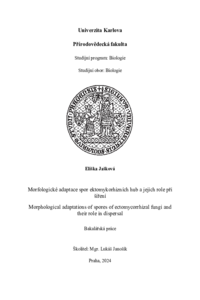Morfologické adaptace spor ektomykorhizních hub a jejich role při šíření
Morphological adaptations of spores of ectomycorrhizal fungi and their role in dispersal
bachelor thesis (DEFENDED)

View/
Permanent link
http://hdl.handle.net/20.500.11956/190142Identifiers
Study Information System: 264946
Collections
- Kvalifikační práce [21433]
Author
Advisor
Referee
Kohout, Petr
Faculty / Institute
Faculty of Science
Discipline
Biology
Department
Department of Botany
Date of defense
3. 6. 2024
Publisher
Univerzita Karlova, Přírodovědecká fakultaLanguage
Czech
Grade
Excellent
Keywords (Czech)
ektomykorhizní houby, Ascomycota, Basidiomycota, funkční znaky, disperze, spora, morfologie, ornamentika, zoochorie, anemochorieKeywords (English)
ectomycorrhizal fungi, Ascomycota, Basidiomycota, functional traits, dispersion, spore, morphology, ornamentation, zoochory, anemochoryMorfologie spor je určující pro vzdálenost a substrát, na který dopadnou. Recentní studie ukazují, že kolonizace vhodného substrátu je důležitější než jen samotné šíření na velkou vzdálenost. Morfologie spor tak zřejmě odráží konkrétní ekologické nároky daného druhu a je ovlivněna selekčním tlakem na jejich efektivní šíření. V případě ektomykorhizních hub, na které je práce zaměřena, je důležitým ekologickým nárokem substrát, kde spora najde vhodného partnera pro ektomykorhizu. Začátek práce je věnován stručné charakteristice ektomykorhizních hub. Hlavní část je rozdělena na dosavadní poznatky o klíčových morfologických znacích ektomykorhizních hub (plodnice, velikost spory, tvar spory a ornamentika buněčné stěny) a specifických způsobech, jakými mohou být jejich spory šířeny. V závěru zmiňuji i možnosti dalšího výzkumu v této oblasti.
The spore morphology determines the distance and the substrate on which they land. Recent studies show that colonization of a suitable substrate is more important than long-distance dispersal itself. Spore morphology therefore likely reflects specific ecological requirements of a particular species and is shaped by the selective pressure on their effective dispersal. In the case of ectomycorrhizal fungi, on which the work is focused, an important ecological requirement is a substrate where the spore can find a suitable partner for ectomycorrhiza. The beginning of the thesis is dedicated to a brief characterization of ectomycorrhizal fungi. The main part is divided into the summary of current knowledge about the key morphological features of ectomycorrhizal fungi (fruiting body, spore size, spore shape and cell wall ornamentation) and the specific ways how their spores can be dispersed. In the end, I also mention the possibilities of further research in this area.
